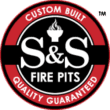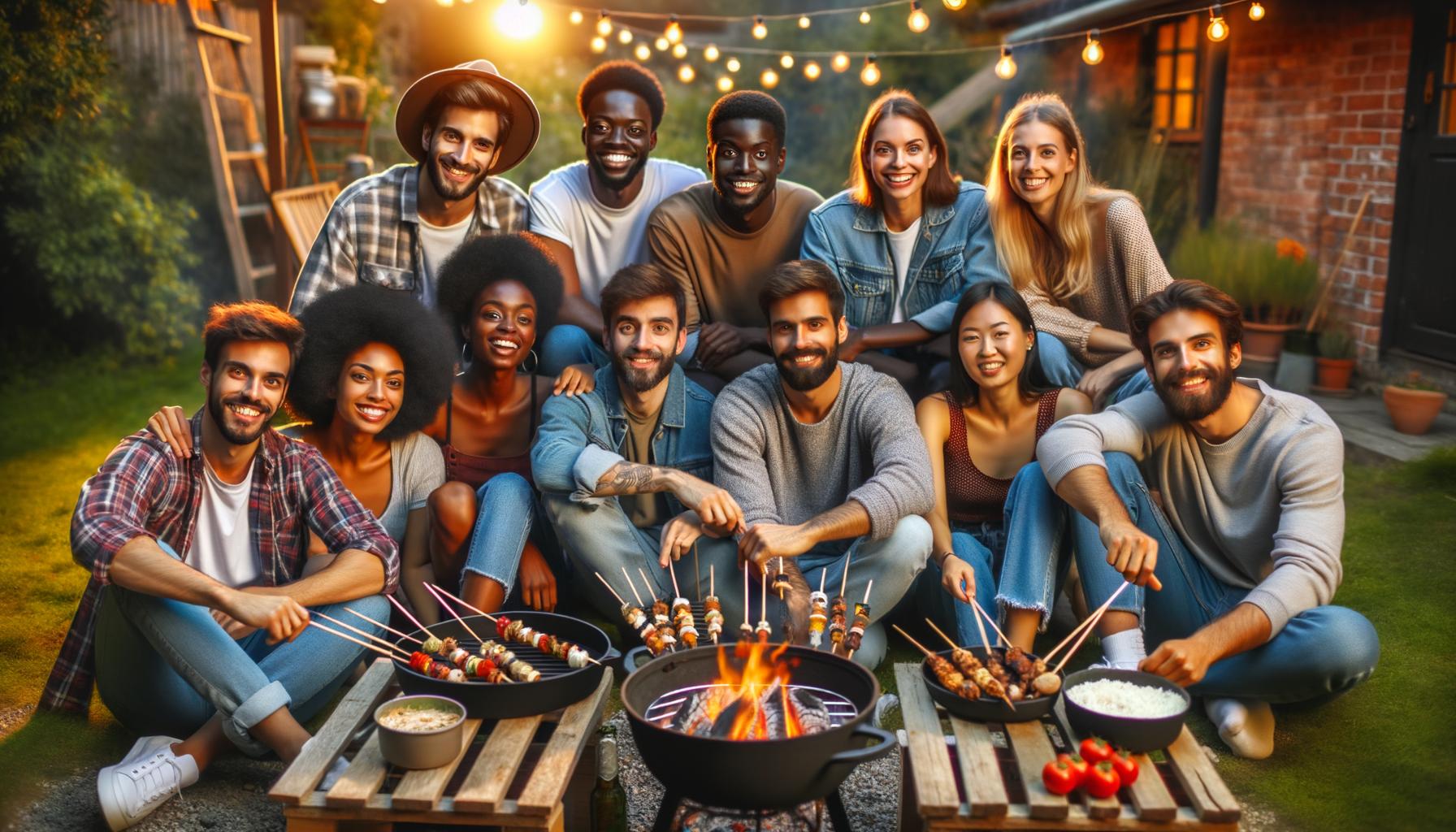
Cooking over a fire pit is an experience like no other, providing both flavor and warmth.
We at S&S Fire Pits are here to guide you through the essentials.
From necessary tools to delicious recipes, we cover everything you need to make the most of your fire pit.
Safety is also key, and we’ll share tips to keep your cooking experience enjoyable and secure.
What Do You Need for Fire Pit Cooking
Cast Iron Cookware
When it comes to fire pit cooking, cast iron cookware is indispensable. It stands up to high temperatures and provides even heat distribution. A sturdy cast iron skillet or Dutch oven is perfect for everything from searing steaks to slow-cooking stews.
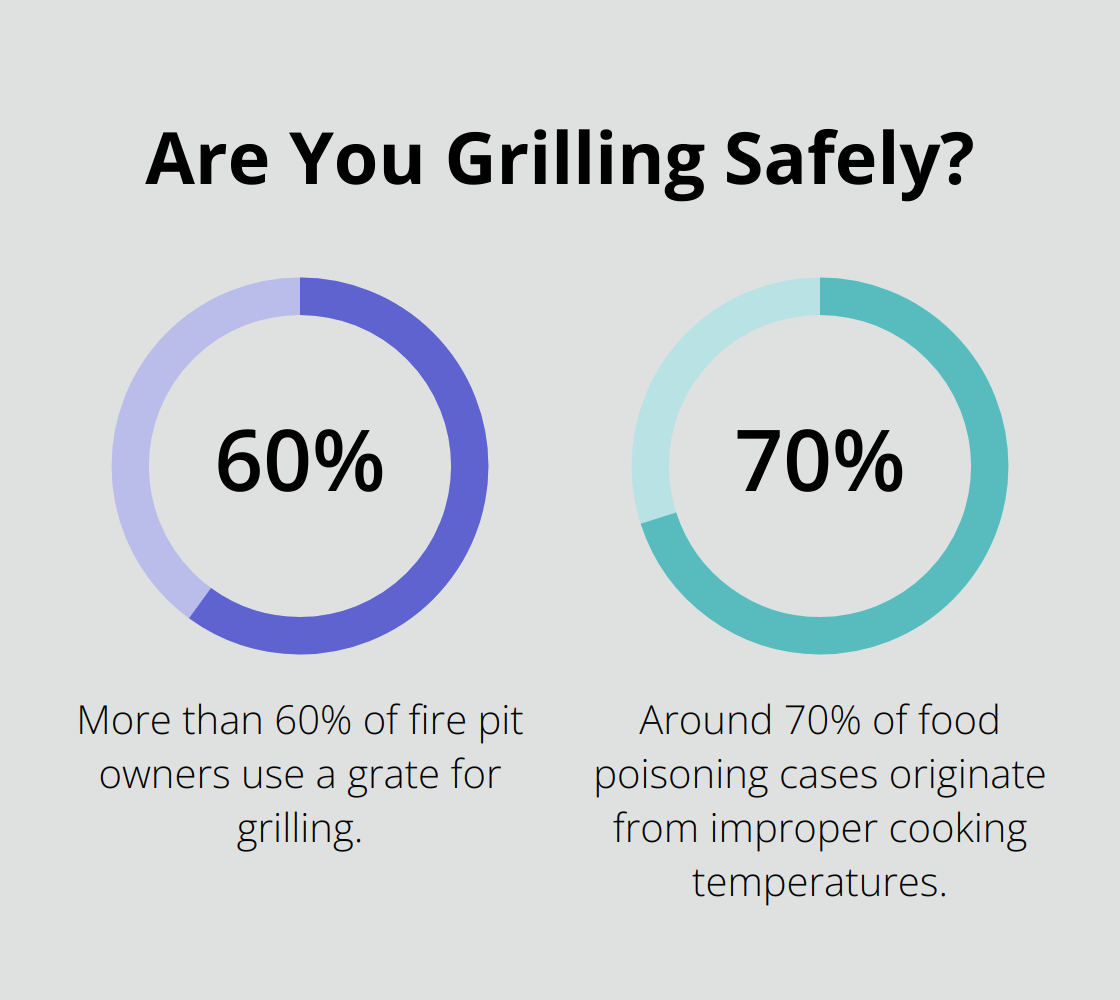
A Dutch oven, used with hot coals, can create mouthwatering dishes like stews and casseroles without burning the food. It’s been documented that a well-maintained cast iron skillet can last for generations. Ensure you have a good lid lifter and hot handle holder as cast iron gets extremely hot.
Grills and Grates
Second on the list are grills and grates. These allow versatile cooking methods. Use a grill grate directly over the flames for grilling meats and vegetables. According to the Hearth, Patio & Barbecue Association, more than 60% of fire pit owners use a grate for grilling. Opt for adjustable grates to easily manage the distance between food and flames.
A cooking tripod with a grate can expand your options, letting you lower and raise your food to control cooking speed. For even more control, consider a swivel grill that attaches to your fire pit.
Cooking Utensils and Accessories
Investing in the right utensils and accessories makes a world of difference. Long-handled metal tongs and spatulas are essential to keep your hands safe from the heat. Fire-resistant gloves are a non-negotiable item. Silicone oven gloves are particularly recommended due to their high heat resistance.
A meat thermometer, essential for any meat preparation, ensures your food is cooked to a safe internal temperature. It’s been observed that around 70% of food poisoning cases originate from improper cooking temperatures. Don’t overlook marshmallow roasting sticks for desserts like smores. Lastly, having a good set of fire starters can speed up the cooking process, letting you get to the fun part quicker.
Equipping yourself with these essential tools will set you up for a successful and enjoyable fire pit cooking experience.
What Recipes Work Best?
Grilled Vegetables and Skewers
Fire pit cooking lets you prepare grilled vegetables and skewers with unmatched flavor. Vegetables like bell peppers, zucchinis, and asparagus can be seasoned with salt, pepper, and olive oil. Thread them onto skewers for easy handling. Studies from the USDA show that grilling vegetables helps retain their nutrients and enhances their natural sweetness.
Master different cooking techniques when grilling vegetables and meat. Shrimp, chicken, and beef skewers marinated with spices can also be grilled directly over the fire. Using a meat thermometer ensures they are cooked to a safe internal temperature of 165°F for poultry and 145°F for red meat.
Campfire Stews and Soups
Campfire stews and soups are ideal for slow cooking over a fire pit. A cast iron Dutch oven is perfect for making hearty dishes like beef stew or chicken soup. Add ingredients like chunks of meat, potatoes, carrots, onions, and seasonings. Simmering them over low heat allows the flavors to meld beautifully.
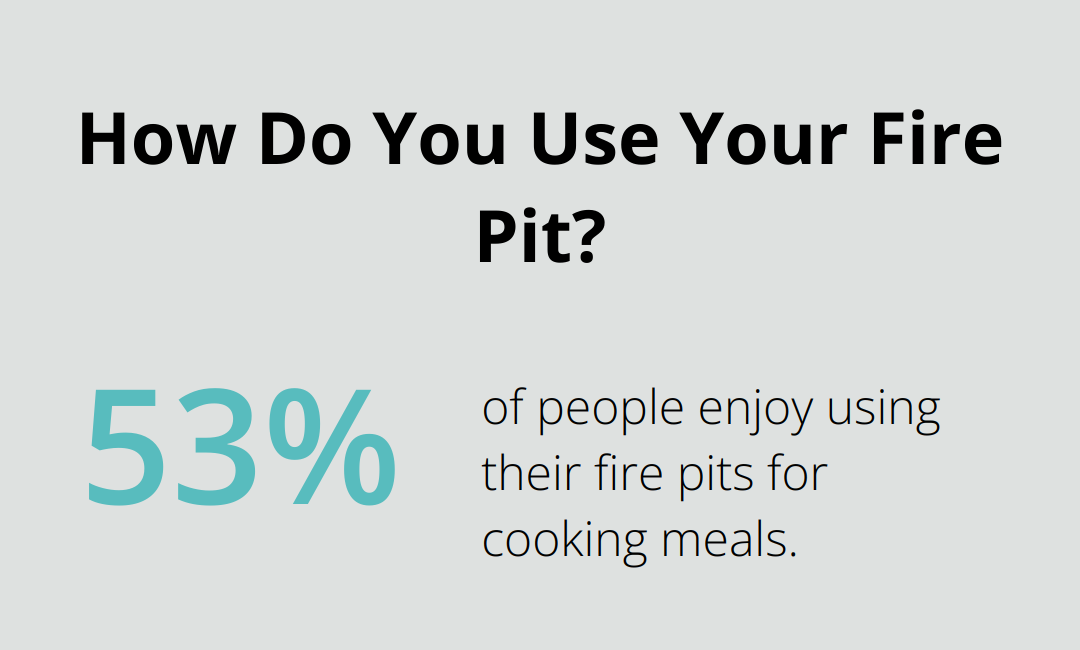
According to a survey by the National Fire Protection Association, 53% of people enjoy using their fire pits for cooking meals. Stews and soups maintain their moisture and are less likely to burn, making them perfect for extended cooking times. Adjust the height of your cooking tripod to control the heat and prevent boiling over.
Desserts like S’mores and Campfire Cones
Fire pit desserts bring joy to both kids and adults. Traditional s’mores made with graham crackers, chocolate, and marshmallows are a must-have. Use long roasting sticks to toast marshmallows to your preferred level of gooeyness. Experts suggest rotating the marshmallow slowly for even caramelization.
For a twist, try campfire cones by filling waffle cones with chocolate chips, mini marshmallows, and fruits like strawberries. Wrap the cones in aluminum foil and place them over the hot coals for about 5–7 minutes. A study by the Harvard T.H. Chan School of Public Health found that engaging in shared activities like cooking fosters better relationships and communication.
Adding these popular recipes to your fire pit repertoire guarantees a delightful and memorable outdoor cooking experience.
Safety Tips
A successful fire pit cooking experience hinges on safety. Neglecting safety can turn a fun activity into a hazard. Following these critical safety tips ensures a safe and enjoyable fire pit cooking environment.
Proper Fire Management
One of the primary considerations in fire pit cooking is managing the fire effectively. Always use dry, seasoned wood. Seasoned wood does have less moisture than green wood, and therefore burns hotter. Building a strong base of hot coals before cooking is essential. It provides even heat and reduces the risk of food burning. Continuously monitor the fire and adjust the wood to maintain consistent heat.
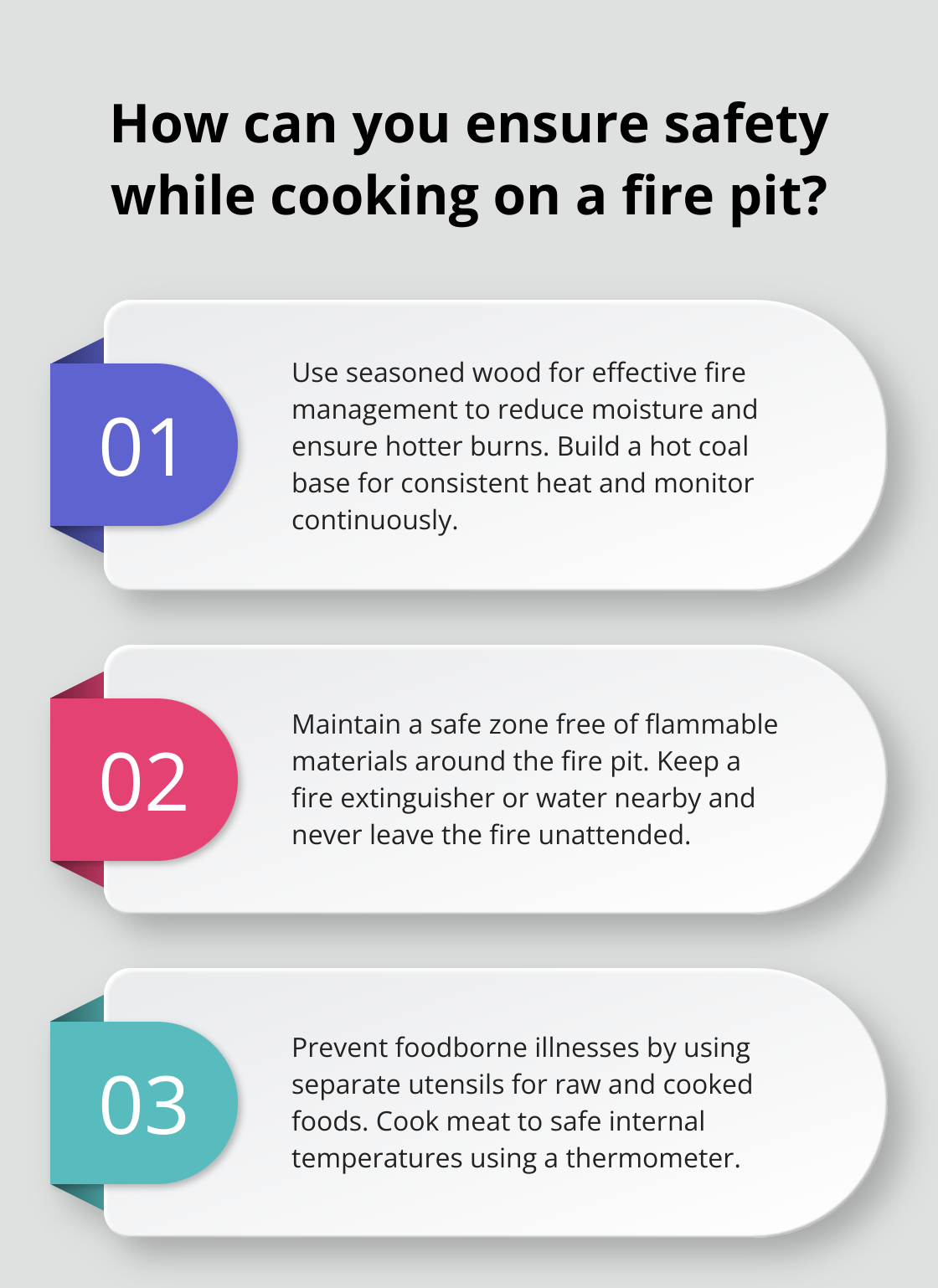
Ensure there is a safe zone around the fire pit. Keep it clear of flammable materials like dry leaves or paper. It’s recommended to keep a fire extinguisher or a bucket of water within reach, just in case the fire gets out of control. Never leave the fire unattended, especially if there are children or pets around.
Food Safety and Hygiene
Foodborne illnesses are a serious concern, so maintaining proper food hygiene is critical. Many people think that once a food has been properly cooked, all disease-causing organisms (pathogens) have been killed. This is not true. Some pathogens can survive the cooking process. Use separate cutting boards and utensils for raw and cooked foods to prevent cross-contamination. Washing hands before and after handling food minimizes the risk.
Always cook meat to safe internal temperatures. A meat thermometer is indispensable here. According to the CDC, consuming undercooked meat is one of the leading causes of food poisoning. Poultry should reach an internal temperature of 165°F, ground meats 160°F, and steaks at least 145°F.
Proper storage of perishables is another important aspect. Keep perishable foods in coolers with ice until they are ready to be cooked. Bacteria can start multiplying quickly if food is left out for more than two hours. In hot weather, this time reduces to one hour.
Safe Handling of Hot Equipment
Handling hot cookware and utensils requires caution. Use fire-resistant gloves to protect your hands from burns. Silicone oven gloves are particularly effective as they withstand high temperatures. Long-handled tools like tongs and spatulas keep you at a safe distance from the flames, reducing the risk of burns.
Never place hot equipment directly on surfaces that can catch fire. Always have a designated spot, preferably on a non-flammable surface, to set down hot pots and pans. Keep an eye out for potential tripping hazards around the cooking area.
In addition, educate everyone around the fire pit about the dangers of touching hot equipment. Ensuring everyone is aware can prevent accidents and burns.
By implementing these safety measures, fire pit cooking can remain an enjoyable and safe activity for everyone involved.
Wrapping Up
Fire pit cooking offers a unique blend of culinary delight and outdoor fun. To get started, essential tools like cast iron cookware, durable grills, adjustable grates, and proper utensils ensure you have everything you need for a seamless cooking experience.
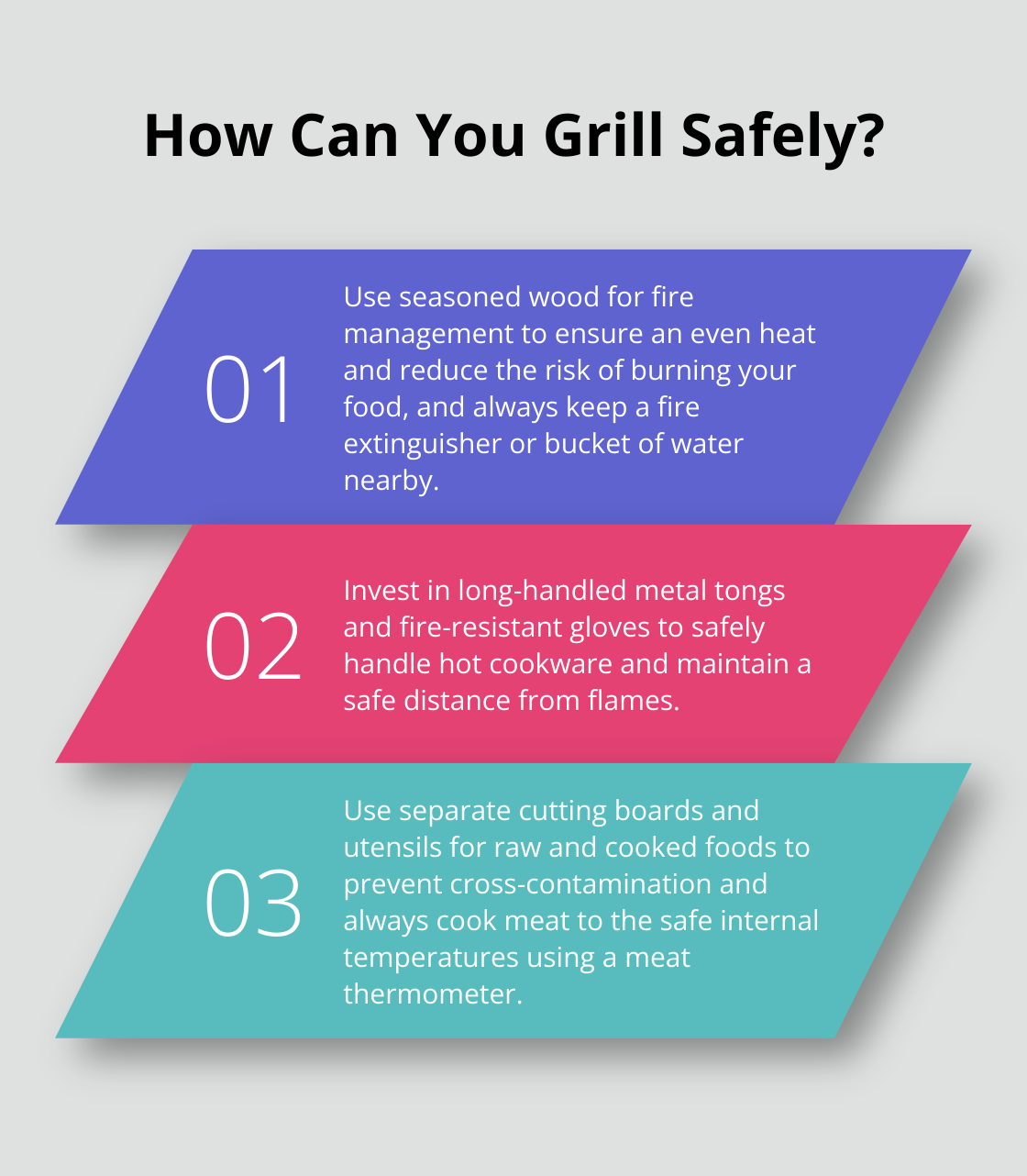
Popular recipes such as grilled vegetables and skewers, hearty campfire stews, and classic desserts like s’mores can transform any gathering into a memorable event. These dishes benefit from the rich flavors imparted by live fire cooking, making them a favorite among fire pit enthusiasts.
Safety remains paramount. Managing your fire properly with seasoned wood, maintaining hygiene to prevent foodborne illnesses, and handling hot equipment with care are all vital practices. These precautions not only protect you and your guests but also keep the fire pit cooking experience enjoyable and hazard-free.
For the perfect fire pit setup, consider S&S Fire Pits. We make handmade, unique fire pits and over 100 different products for outdoor living. Crafted from corten solid USA steel, our products are built to last a lifetime, ensuring that your fire pit adventures are supported by the highest quality equipment available.
Embrace the art of fire pit cooking and enjoy the warmth, flavors, and camaraderie it brings.
